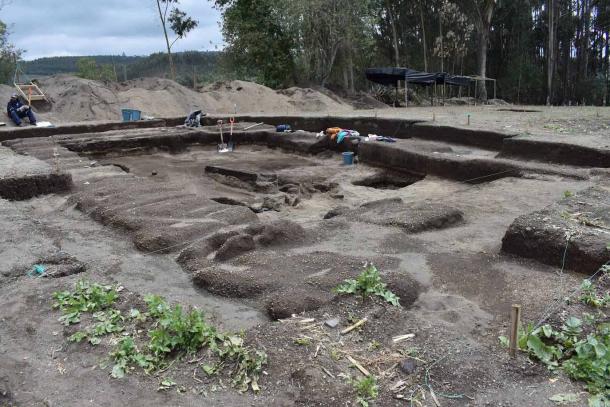
Mysterious Artifacts Found in Ancient Inca Cemetery in Ecuador
The construction of a long-awaited irrigation water tank will have to wait a little longer for farmers living in the central region of Ecuador. When work began they found ancient human remains and when the archaeological team was brought in for a salvage mission, they unearthed more skeletons in the earth. But the skeletal remains of people who lived roughly 500 years ago are only part of the story. A couple of strange artifacts found in the ancient Inca cemetery have created new puzzles for local archaeologists to try to solve.
The First Signs of the Ancient Inca Cemetery
According to El Comercio, the first signs of the ancient Inca cemetery under a field in Mulaló – a rural district of Latacunga in the province of Cotopaxi, came in the form of a skull and a pot that were unearthed in 2019.
It didn’t take long for local authorities to decide that the artificial reservoir local people had been waiting to see for more than a decade would be put on hold a little longer so an archaeological team could come in and find out what else was under the land. However, there has been a lack of federal funding for archaeological research, so the mayor of Latacunga, Byron Cardenas, hired an archaeologist to complete a salvage mission and investigation of the site’s archaeological contents.

The ancient Inca site during excavations. (EFE/Byron Ortiz/Mulalo Archaeological Project – Salatilin)
Esteban Acosta, the archaeologist in charge of excavations at the site, described the site to reporters, saying, “We discovered a rectangular Inca cancha (a mass of earth and clay that served as a foundation for homes and fortifications and which are found throughout the Andean region) measuring 13 meters east to west and seven meters north to south.”
In the Andes, canchas were generally made out of stone, but at the Mulaló site, Acosta says that the stones are missing because they were probably “taken away to build houses and only part of the foundation remained.”
- The Inca Empire: What Made it so Powerful?
- Curious Ceramics: Traces of Mysterious Pre-Hispanic Culture Emerge in Ecuador
- Ecuadorian Infants Discovered Wearing Child Skull ‘Helmets’
An Ancient Inca-Colonial Fusion
A total of 12 skeletons, both adults and children, have been discovered. Water filtration has badly damaged the skeletal remains, however Acosta says that “What’s in better shape are the teeth of almost all of (the skeletons).” He hopes that genetic and morphological analyses of the teeth will help to determine if the people found in the Inca cemetery belonged to the same family or not. The archaeologist told Cotopaxi Noticias the results of the analyses should be available in three months.

12 skeletons were found in the ancient Inca cemetery. (EFE/Byron Ortiz/Mulalo Archaeological Project - Salatilin)
The Archaeology News Network reports that the skeletal remains were found with artifacts buried less than a meter into the earth. The archaeological team believes these are ancient Inca remains and artifacts which date to approximately 1450 to 1540 AD. That was a time when the people living in the area were transitioning from the late Inca culture to the beginning of Spanish colonialism.
The team was able to identify the graves as remnants of the Inca period due to several of the artifacts that were discovered at the site. In particular, the location being in Inca territory at that time and the Inca style ceramic vessels were the clues needed to reach this conclusion.

Well-preserved ceramic vessels found at the site. (EFE/Byron Ortiz/Mulalo Archaeological Project – Salatilin)
Among the vessels, the team has found a long-neck pitcher which has traditionally been used to serve a popular Andean corn-based fermented beverage called chicha and some drinking vessels without handles.
Puzzling Artifacts
A couple of the ancient Inca ceramics stand out from the rest due to the symbols with which they are decorated. Acosta’s team have identified a Christian cross and what appears to be the letter “W” on the vessels. No one knows what the “W” could be referring to - a name? a place? or is it just a decorative shape? “This type of decoration hadn’t been seen before, which makes us think that it’s from the time of the Spanish colonial transition,” Acosta says.

Some of the ceramics are decorated with designs that are not associated with the ancient Inca culture. (EFE/Byron Ortiz/Mulalo Archaeological Project - Salatilin)
One other artifact of interest, which unfortunately hasn’t appeared in any pictures of the site’s artifacts available to press yet, is a ring that was found with one of the skeletons. Acosta says that he’s not sure what it’s made of, but it’s “not copper nor a known metal” and he’s sure that is not associated with the ancient Inca culture.
Acosta believes that further analysis of the finds will provide new archaeological evidence on what life was like during the Spanish conquest and the transition to colonial rule in this region. This is important because most of the information currently available of the transitional period comes from historical resources.
According to El Comercio, local authorities plan to have the skeletal remains returned to Mulaló upon completion of the lab analyses. In the meantime, the area where the ancient Inca graves were found has been fenced off and local police and neighbors are keeping watch over the site to prevent looting by the infamous huaqueros.
Top Image: Aerial view of the ancient Inca cemetery recently discovered in Ecuador. Source: EFE/Byron Ortiz/Mulalo Archaeological Project - Salatilin















